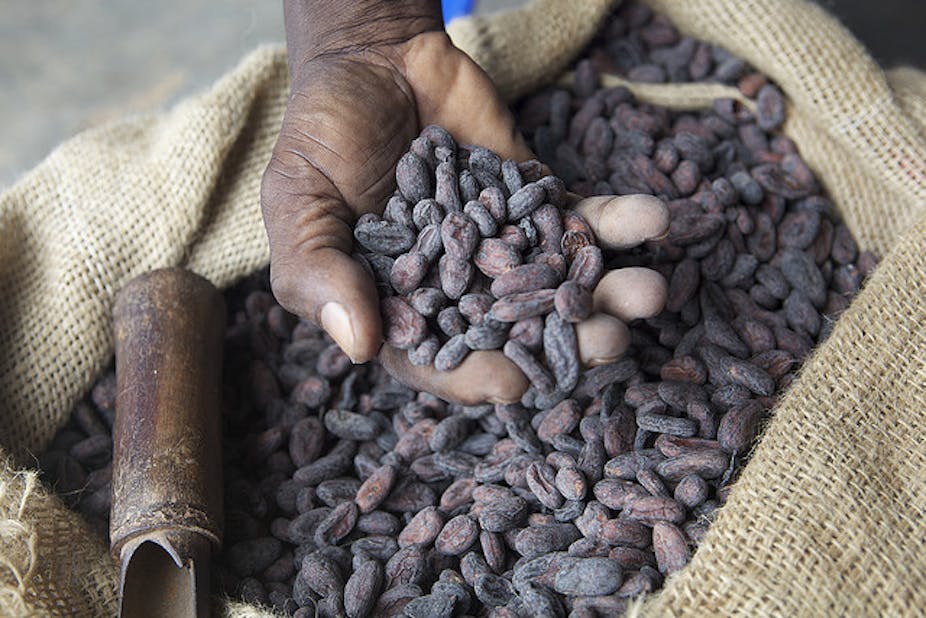Chocolate – from the humble confectionery bar to single-origin gourmet dark chocolate - is enjoyed by most Australians as a readily available treat. However, chocolate manufacturers are worried that cocoa production may not be able to meet the rapidly increasing demand for chocolate in the developing economies of China, India and Brazil.
A major international cocoa processor, Barry Callebaut, recently warned that annual cocoa production in 2020 would have to rise by 25%, or 1 million tonnes, to keep pace with demand. However our ability to sustain even current production levels is threatened by climate change, land degradation, pests and diseases, alternative crops, labour shortages and political instability.
Cocoa is a widely-traded and highly speculated commodity, and despite its luxury image farmers reap few rewards. The world market price of beans fluctuates wildly because of speculation, but typically amounts to only 7% of the price of a chocolate bar. Depending on the length of the marketing chain, farmers might receive between 40 and 70% of the market price.

Attempts to segment the chocolate market using fair-trade, organic or rainforest-friendly appellations often provide little real benefit to farmers, and in many cases impose extra costs.
Cocoa is a major source of income for millions of smallholder farmers in rural areas of the wet tropics in West Africa, South America, Southeast Asia and the Pacific. Rather than improving yield from existing crops, farmers have met demand over the past century by expanding their plantings, usually involving deforestation. Spare land is now scarce and a Gates Foundation study suggests that rising temperatures will render up to half the current area under cocoa plantation unsuitable by 2050.
Farmers plant cocoa seeds or cuttings and nurture small trees for two to three years until flowering begins. Six months later the ripe pods are harvested, the pale beans scooped out, and then fermented for several days to develop the chocolate colour, aroma and flavour. After drying, the beans are sold to buyers and enter the marketing chain.
Cocoa trees can yield well over a tonne of dry cocoa beans per hectare. However, the cumulative effects of disease, pests and declining soil fertility mean farmers only average 10% of potential yields from cocoa plants. Disease reduces cocoa production by around 30%, and in some areas can entirely eradicate the plants.

Brazil, previously one of the top three cocoa producers, had its production decimated by Witches’ Broom disease in the 1990s, and much of South America is currently threatened by the spread of Frosty Pod Rot disease.
While the soils of newly-cleared forests are usually fertile and support heavy cocoa yields for a few years, organic matter and nutrients are rapidly exhausted if not replenished by fertilisers. While fertilisers are usually applied to support the establishment of newly-planted seedlings, their use on mature trees is erratic and price-sensitive.
For these farmers, cocoa trees signify land ownership and function like a dependable ATM machine that can be visited when school fees or hospital bills need to be paid. While the technology to maintain sustainable yields in the face of disease is straightforward, it requires increased labour and investment that very few smallholder farmers have access to. For impoverished farmers, the poor returns from cocoa do not justify investment. Even if they had the money, knowledge, equipment and labour to make investments, farmers lack informed and objective technical or logistic support to decide what investment is needed.
Not only are most cocoa trees beyond their most productive years, but the farmers are also ageing. Young people are attracted to cities and their departure cripples the labour-intensive cocoa industry. In the world’s largest cocoa producer, Cote d’Ivoire, a decade of civil war has depleted the supply of labour and cocoa production is stagnant.

Older farmers are risk-averse and less likely to change their farming methods, while more entrepreneurial cocoa farmers are lured by alternative, and more lucrative, crops. During the spike in oil prices in 2008, many farmers in Sulawesi, Indonesia, the world’s third largest producer, replaced cocoa with maize, because the US biofuel subsidies had forced up the world price. Cocoa trees were turned to charcoal for use in the kitchen because kerosene had become too expensive. Fertilisers became prohibitively expensive.
So how do we sustain our chocolate dependency? The key is to improve the sustainability, productivity and viability of smallholder cocoa production by supporting farmers and scientists working in the industry.
Since 2001, Ghana has successfully boosted cocoa production by reducing the number of middlemen in the marketing chain, along with providing a national pesticide spraying program. Disappointingly, increased production has not improved the real income or living standards of most farmers.
Well-educated farmers gained the most benefit, indicating that the key to improving cocoa production is education, both general and technical. While aid donors and government agencies can help to initiate training programs, experience shows that private sector champions, in this case cocoa buyers and chocolate companies, are the key to delivering effective and sustained improvements in yield.
When combined with comprehensive education and health programs, farmer training is a powerful driver of rural poverty alleviation, reduced rainforest clearing and political and social stability. Improving the living standards of smallholder cocoa farmers will also secure future supplies of affordable Easter eggs.

